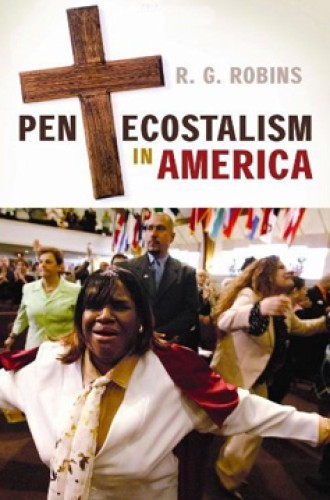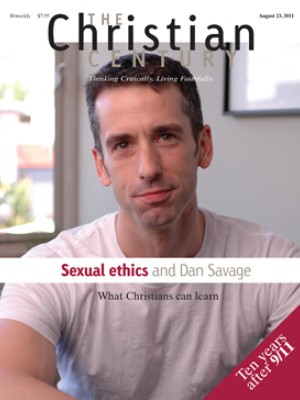Pentecostalism in America, by R. G. Robins
Walk through the book section at your local Walmart and chances are you'll find popular titles written by individuals within the Pentecostal and charismatic movement, such as Joyce Meyer and Joel Osteen. Flip on your television and you might encounter one of the most recognized ministers with a Pentecostal background, T. D. Jakes, dispensing advice alongside Dr. Phil. Next time you browse for nutritional supplements online, you may come across Divine Health nutritional products, promoted by Don Colbert, a charismatic health guru who graduated from Oral Roberts University School of Medicine. Sarah Palin, vice presidential candidate in 2008, grew up attending the Pentecostal Wasilla (Alaska) Assembly of God.
The Pentecostal movement, which has become a major player in the American religious and not-so-religious marketplace, had its humble beginnings in the early 1900s. The earliest Pentecostals quickly splintered into a variety of denominations, dividing along racial lines and over a variety of doctrinal issues. Charismatic renewal and the so-called third wave spread Pentecostal emphases to a much broader audience during the second half of the 20th century and introduced several new permutations of the Spirit-filled life in the process. The presence of numerous independent ministries throughout the history of the Pentecostal tradition muddles the complicated story further.
Read our latest issue or browse back issues.
Thankfully, several first-rate historical studies of Pentecostalism in the United States can help interested observers map out key aspects of the tradition (see, for example, Grant Wacker's Heaven Below: Early Pentecostals and American Culture and Randall Stephens's The Fire Spreads: Holiness and Pentecostalism in the American South). For good reason these studies narrow the field of vision by focusing on a particular time period, region, leader or ethnic group. A few brave souls have attempted to provide an overview of the full spectrum of Pentecostal churches and trends, often situating their discussion of Pentecostalism in the United States in the context of global developments. Pentecostalism in America, by R. G. Robins, provides by far the best broadly synthetic treatment to date.
Robins is particularly well suited for the undertaking. Not only does he have considerable talent as a historian and writer, he cut his teeth on the "ancient tradition" of East Texas Pentecostalism, where "protocol decreed that services should be held Wednesday night, Friday night, and twice on Sundays, with the first Monday of each month set aside for fellowship meeting and youth rally." Having time and time again seen adults "publicly scream, weep, run, leap, thrash, flail, fall prostrate, speak in tongues, and generally cavort about," Robins knows whereof he speaks. He suggests that the book "is a by-product of my attempt to come to terms with growing up Pentecostal."
And what a beautiful by-product it is. The carefully nuanced yet accessible volume situates American Pentecostalism within the broader context of American Christianity and U.S. history as a whole. Robins expertly interweaves discussions of race, class, education, gender, globalization and other issues. He is especially adept at highlighting the "zones of convergence" that appeared outside of the formal Pentecostal denominations in the second half of the 20th century and facilitated Pentecostalism's growing influence on more established forms of Christianity in the U.S. Examples include the Full Gospel Business Men's Fellowship International, Oral Roberts University, Aglow International and the Jesus People movement.
Robins suggests that the significance of such sites of "syncretistic interface" increased with time. "Denominations provided the motive force of Pentecostalism during most of its first century," he writes, "but by the end of the 20th century the center of dynamism had begun to shift to the zones where denominational Pentecostalism, independent Pentecostalism, and the charismatic movement converged and overlapped." The various megachurches built by figures such as T. D. Jakes epitomized this transition, as did the formation of the Association of Vineyard Churches and the Full Gospel Baptist Church Fellowship.
Robins also shines a welcome spotlight on a significant racial divide between white and black Pentecostals that has persisted over the past several decades. Awareness of such divisions has prompted efforts at racial reconciliation, which most notably produced the Memphis Miracle in 1994, but significant boundaries remain. The racial gap is especially apparent in Pentecostal political culture. By and large, predominantly white congregations joined a larger evangelical exodus from the Democratic Party and now hew much closer to the political right, while African-American Pentecostals increasingly identify with the black church and are "far more supportive of Great Society-style intervention on behalf of the needy and oppressed."
Though Robins does not highlight its significance in relation to issues of race, in the latter decades of the 20th century, the burgeoning Word of Faith, or positive confession, branch of the movement transcended racial lines as it established itself as a major player within Pentecostal and charismatic circles. More than a few believers were thrilled to hear that "the child of God can speak into being anything that is consistent with the will of God." The appeal of Word of Faith-style emphasis to a wide swath of Pentecostals and charismatics also calls attention to one factor I wish Robins had paid more attention to: the convergence of Pentecostal and charismatic spirituality with religious perspectives drawn from well outside the bounds of more traditional forms of Christianity.
Pentecostals who touted the power of positive thought and speech to effect healing and the acquisition of wealth tapped into a powerful current in American religion that originated in the New Thought tradition of the late 19th century and was popularized by figures such as Ralph Waldo Trine and Norman Vincent Peale and later by Oprah Winfrey. Though Robins does highlight Pentecostals who, in the words of Oral Roberts, taught about the power of believing that "something good is going to happen to you," he does not situate these trends within the broader American religious context. The extent to which New Thought and its successors influenced Pentecostalism can be debated, but the overlap is unmistakable, and several of the most high-profile Pentecostal and charismatic figures have exploited these similarities on their path to prominence. By neglecting to discuss the influence of traditions such as New Thought on Pentecostal culture, Robins missed an opportunity to move beyond his focus on the evangelicalization of the movement and to demonstrate the significant points of contact linking Pentecostals with American religionists of a very different stripe.
Few religious traditions can rival the success of Pentecostalism in the United States over the course of the 20th century, and I can think of no better guide than Pentecostalism in America for identifying and making sense of the Pentecostal threads woven into the tapestry of American culture.






